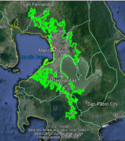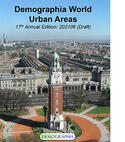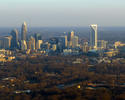Survival of the City: Living and Thriving in an Age of Isolation, by Harvard University economists Edward Glaeser and David Cutler characterizes the pandemic as a serious “existential threat to the urban world, because the human proximity that enables contagion is the defining characteristic of the city” read more »
City Sector Model
Survival of the City: The Need to Reopen the Metropolitan Frontier (Review)
Greater Manila 2020: The Evolving Urban Form
In 2021, the Manila built up urban area is estimated to have a population of 24.0 million, making it the fourth largest urban area in the world, according to Demographia World Urban Areas, covering 873 square kilometers and with a population density of 12,801 per square kilometer (33,135 per square mile). Only Tokyo, Jakarta and Delhi have larger populations. By comparison, the 2021 population of the New York urban area is 20.9 million. read more »
Changing Boundaries, Changing Perceptions
What if I told you that Chicago is a midsized, dense urban hub of 800,000 people, surrounded by more than 400 suburbs anchoring a large metro area of 9.5 million? Or that Indianapolis reached its peak population of 476,000 in 1960, and has slipped below 300,000 for the first time since 1930? Or that New York City reached its population peak of 3.4 million in 1950, lost nearly a million people to fall to 2.6 million by 1980, and once again crossed the 3 million person threshold just this past decade? read more »
- Login to post comments
Focusing on World Megacities: Demographia World Urban Areas, 2021
The 2021 edition of Demographia World Urban Areas includes current population estimates for the 985 identified built-up urban areas (Note 1 describes the background and methodology) with at least 500,000 population.This is a smaller number than last year, due to a methodology that rendered somewhat lower populations for some urban areas. read more »
- Login to post comments
America’s Post-Pandemic Geography
Even as vaccination increases across the United States and an end to the tragedy of the Covid-19 pandemic seems in sight, the economic, fiscal, political, and geographic fallout from the virus cannot be overstated: a massive public health crisis that left more than half a million Americans dead, an economic catastrophe that caused record unemployment and small-business closures, and a seismic political event that surely helped tip the presidential election. The pandemic will pass, and the economy will revive, as it is already doing. read more »
- Login to post comments
Economy Thrives While CBDs Dive
The argument that central business districts (CBDs) are the engine rooms of the Australian economy is being tested right now. read more »
- Login to post comments
Florida Downtown Commutes Fall the Least from COVID, Recover the Most
Mass transit may have taken the biggest hit from Covid-19, declining by 55% in the New York urban area, 43% in Los Angeles and 57% in Chicago, but car commutes also suffered. The latest INRIX Global Traffic Scorecard finds that US vehicle traffic to downtowns (central business districts) also declined by a substantial 44% in the pandemic year of 2020. According to Bob Pishue, an INRIX traffic analyst: “COVID-19 has completely transformed when, where and how people move. read more »
- Login to post comments
Understanding Major Metropolitan Domestic Migration
It has been clear for years that net domestic migration to and from major metropolitan areas (over 1 million population) has been characterized by moving out of costly areas, like Los Angeles, the San Francisco Bay Area and New York to much less expensive areas, like Dallas-Fort Worth, Houston, Atlanta and Nashville. However, within these metropolitan areas, there are substantial variations. read more »
- Login to post comments
A Change Is Gonna Come — Anyway
Frequent readers here may have seen me write about my experience growing up in 1970s Detroit. I’ve often said that seeking ways to improve the city and not abandon it, is what propelled me into a career in urban planning. I wanted to be a change agent for cities. Today, more than thirty years into my career, I’m proud of the stature cities have gained over that time; I’m proud of my contribution to it. However, I feel as if cities have risen in prominence in spite of the efforts of planners, not because of them. read more »
- Login to post comments
Housing Affordability and the Pandemic
The median price of homes in Auckland, New Zealand’s largest city, grew by $100,000 in February, reports the Real Estate Institute of New Zealand. That means prices were growing by $25,000 a week. The good news is that these are New Zealand dollars, which are only worth about 72 cents U.S., which means prices grew by “only” US$18,000 a week. read more »






















